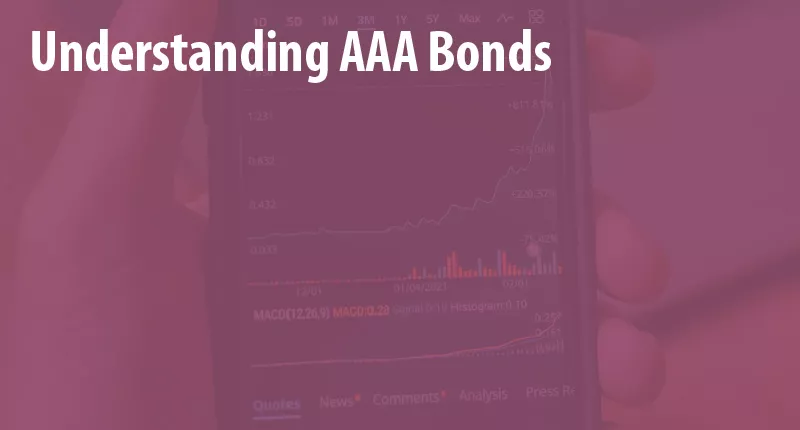
TABLE OF CONTENTS
If you’re looking to get a better understanding of investments or explore bonds, you may come across a term known as AAA bonds. Bonds can be used in the business funding process but can be confusing to new business owners. In this article, we will explore the definition of AAA corporate bonds, the components of a bond rating, types of bonds, and the benefits of an AAA credit rating. Read on to find out everything you need to know about corporate bonds and their ratings.
What is an AAA Bond Rating?

Let’s start at the beginning. An AAA bond rating Is the highest rating that one of the major credit rating agencies can assign to an issuer’s bonds. Today, there are three major credit rating agencies – Moody’s, Standard & Poor’s, and Fitch. These three agencies provide credit ratings for different types of debt securities. These securities include debt issues and corporate bonds, among other products.
When rating debt issues, all three agencies have a unique scale that they use. All three use AAA in their rating system, having it represent the highest. Please note that Moody’s uses “Aaa” to represent the highest rating. When a bond has an AAA credit, that means that the creditworthiness is extremely high. The issuers have the lowest risk of default and have been able to meet their financial commitments in the past.
As a result, issuers who have AAA credit ratings do not struggle to find investors. However, the bonds offered on AAA credit have lower yields than those found on other tiers. It’s important to understand that an AAA credit is not a guarantee that the issuer will not default. The chances of a default are lower than a bond with a lower rating, however, there is still some risk that exists.
AAA ratings to companies
Companies can also receive AAA credit ratings. According to Standard & Poor, it only awards AAA to those that have an “extremely strong capacity to meet financial commitments.” Moody’s, Fitch, and Standard & Poor look at the debt of the company and factors including:
- Profit margins
- Tax burden
- Pension obligations
- Earnings growth
- Revenue growth
- Future industry outlook
- Regulatory climate
- Debt load, especially as it relates to cash flow
There were well over 60 publicly available investments in companies that were rated as AAA in their debt issuances during the early 1990s. As of June 2020, only two companies remain with a AAA credit rating – Johnson and Johnson and Microsoft.
Breaking Down Bond Rating
Bond ratings are a method of measuring the creditworthiness of a bond. Creditworthiness is how lenders determine how worthy you are to receive new credit or the likelihood you will default on debt obligations.
This rating corresponds with the cost of borrowing for the issuer. A letter grade is typically assigned to these bonds to represent its credit quality. Standard & Poor’s, Moody’s, and Fitch are the three private independent credit rating agencies that evaluate an issuer’s ability to repay a bond (interest and principal) on time.
A lower interest rate is assigned to issuers who have a higher bond rating. The rating is determining using internal and external factors of the issuer. For example, an internal influence would include the overall strength rating of the bank. This is a measure that looks at how likely it is for the organization to need external monetary support. Examples of external influences include networks with other interested parties like local government agencies.
Issuer bond ratings and what they mean to investors
Different bond ratings have different meanings. In the same sense, these ratings indicate certain messages to investors or potential funding sources.
- AAA to AA: These are known as investment-grade bonds. Investors consider bonds in this grade to have a high likelihood of getting your investment back, plus interest. However, the interest on these bonds is generally lower than what you see with bonds that have a lower rating.
- A to BBB: These are medium-quality bonds. Investors in these bonds will likely receive a higher interest rate than they would with a AAA or AA bond.
- BB to C: These are lower quality bonds, also called “junk bonds.” The interest rates on these bonds are higher than other categories due to the associated risk. It is still possible to find some good investments, but investors should carefully research bonds in this category before making a decision. The lowest rating Moody’s grants is a C.
- D: An issuer will receive this rating if it is already in default on some of its debt.

One point to keep in mind is that credit rating agencies can be slow to react to changes with issuers. For example, during the 2008 financial crash, the agencies did not consider the risk and conditions quickly enough. Many issuers that received government bailouts or became bankrupt had maintained high ratings.
Investors should ensure that they are doing additional research when looking for investment opportunities and not just consider the issuer’s rating.
Municipal bond types
Municipal bonds are issued as general obligation bonds or revenue bonds. The sources of income varies by the type of bond. General obligation bonds levy taxes to raise capital. Revenue bonds use certain income-generating sources to repay the bond, such as fees.
Secured vs unsecured bonds
Other types of bonds that issuers can sell are secured and unsecured bonds. However, there is a different level of risk that comes with each of these bond types.
With secured bonds, investors will pledge a specific asset as collateral. If the issuer defaults on the bond, then the creditor has a claim to that asset. Real Estate, machinery, and equipment are examples of tangible items that you can use as collateral to secure bonds. The credit rating of an issuer’s secured bonds is typically higher than their unsecured bonds.
Unsecured bonds are backed by the issuer’s promise to repay the bond. As a result, the issuer’s sources of income influence the credit rating more.
Benefits of an AAA Credit Rating
Having an AAA rating is very beneficial for issuers with this rating. The cost of borrowing for an issuer is lower when they have corporate bonds with an AAA status. In addition, companies with a AAA rating are more capable of borrowing large sums of money compared to fixed-income institutions that have a lower credit rating. As of February 2020, only two companies have AAA ratings: Johnson & Johnson and Microsoft.
Having more access to credit allows these companies to grow at a lower cost of borrowing. Therefore, these funds go to activities like expanding into a new market, buying a competitor, or creating new products.
Now that you understand how AAA corporate bonds work, you can continue to explore different investment opportunities.





